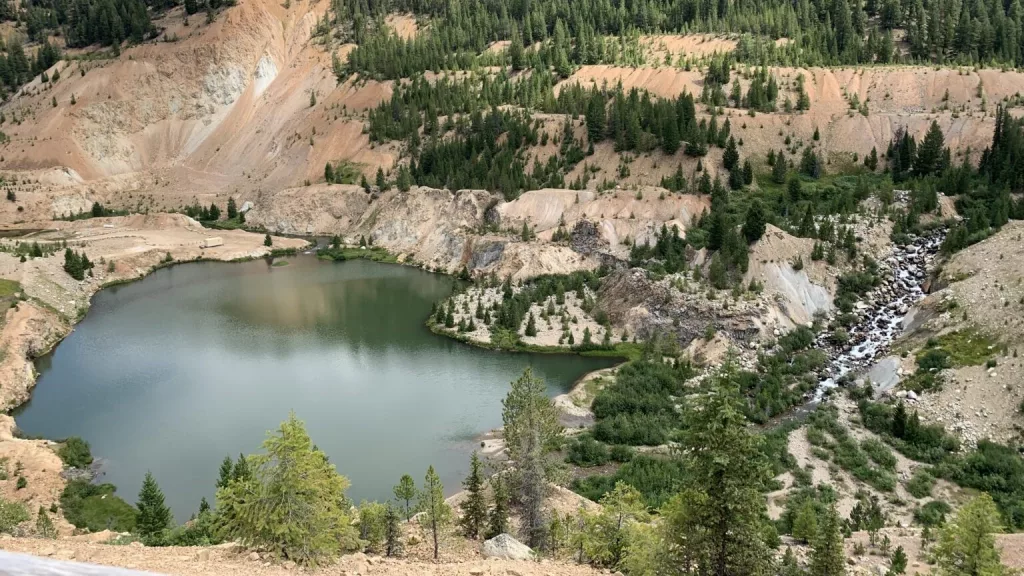(McCall, ID) The U.S. Forest Service has issued a final record of decision approving the Stibnite Gold Mine Project in Central Idaho’s Payette National Forest, green-lighting what could become one of the largest gold mines in the United States.
A company called Perpetua Resources – formerly known as Midas Gold – seeks to resume mining gold, silver and the chemical element antimony at the Stibnite Gold Mine. Mining at the site dates back to 1899 and the Thunder Mountain Gold Rush. Metals mined at Stibnite contributed to the World War II effort.
But by 1992 mining had ceased and Stibnite’s open pit mine was abandoned, polluting the East Fork of the South Fork of the Salmon River with arsenic and sediment, the Idaho Capital Sun previously reported.
Perpetua Resources says Stibnite is still loaded with gold and an element called antimony. The company has promised to clean up some of the historic mine waste, reprocess and safely store historic mine tailings and restore some waterways and fish habitat.
In a statement released Monday, Perpetua Resources welcomed approval of the mine. The company highlighted the jobs it will create and promoted the mining of antimony, a chemical element found in minerals that Perpetua Resources said can be used to make ammunition and liquid metal batteries.
Perpetua Resources officials said approving Stibnite Gold Mine unlocks one of the largest domestic supplies of antimony, which the company said China is restricting exports of.
“We are thrilled to receive our final record of decision from the Forest Service,” Jon Cherry, president and CEO of Perpetua Resources, said in a written statement. “This approval elevates the Stibnite Gold Project to an elite class of projects in America that have cleared NEPA (the National Environmental Policy Act). The Stibnite Gold Project can deliver decisive wins for our communities, the environment, the economy and our national security.”
Perpetua Resources officials said the permitting process has taken eight years.
Conservationists, Nez Perce Tribe say mine will do more harm to Idaho public lands, endangered salmon
Conservation groups, including the Idaho Conservation League, and the Nez Perce Tribe opposed Stibnite’s approval, saying resuming mining will disturb a much larger area of forest than the previous operation and could threaten habitat of endangered salmon.
Stibnite Gold Mine is located in Valley County near the tiny town of Yellow Pine, just outside the boundary of the Frank Church-River of No Return Wilderness. The Frank Church-River of No Return Wilderness is the largest contiguous wilderness area in the lower 48. The rugged wilderness area is home to prominent mountains, whitewater rivers, deep canyons and a diverse species of plants and animals including wolves, bears, beavers, endangered wolverines, and endangered salmon.
Opponents said Stibnite and Perpetua Resources are not doing enough to protect salmon and the environment.
“The Stibnite Gold Project is the equivalent of high-risk, open heart surgery for the East Fork South Fork Salmon River, and the watershed will be worse off as a result, not better,” John Robison, Idaho Conservation League’s public lands and wildlife director, said in a written statement. “We are deeply disappointed that the Forest Service dismissed our suggestions to correct significant flaws in the project. Even the Forest Service’s own analysis states that doing nothing is better for the environment than building the Stibnite Gold Project.”
In September, the U.S. Forest Service issued a draft approval to resume mining at Stibnite, the Idaho Capital Sun previously reported.
Idaho’s Republican congressional delegation supports Stibnite Gold Mine approval
All four members of Idaho’s congressional delegation – U.S. Sens. Mike Crapo and Jim Risch, and U.S. Reps. Mike Simpson and Russ Fulcher – issued a written statement applauding the mine’s approval. In their statement, the Republican congressman highlighted mining for antimony.
“For too long, we have let China hold the cards when it comes to critical mineral production. This Record of Decision is a vital first step in advancing the production of American antimony and strengthening our national defense,” Crapo, Fulcher, Risch and Simpson said in a joint written statement issued Monday. “Still, we must significantly reform the permitting processes to effectively compete with China and fully leverage the resources in our backyard.”
Officials with the Idaho Conservation League said antimony is an important resource, but said gold is really the focus of the Stibnite Gold Mine and would generate 94% of the project’s profits.
“Let’s be clear — this is a taxpayer financed gold mine,” Robison said. “Perpetua never offered and the Forest Service never analyzed a targeted antimony mining proposal that would entail much less surface disturbance, mine waste and overall impact. What’s more, having a small percent of antimony in a gold project should not give anyone a pass for a project that could end up doing immeasurable harm.”
In a news release issued Monday, the Idaho Department of Environmental Quality announced it is releasing an Idaho Pollutant Discharge Elimination Systems, or IPEDS, preliminary draft permit to Perpetua Resources. Following the review, officials with the Idaho Department of Environmental Quality said they will post the draft permit along with any revisions to the department’s website for public review.
This story first appeared on Idaho Capital Sun.





